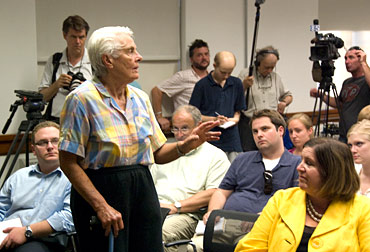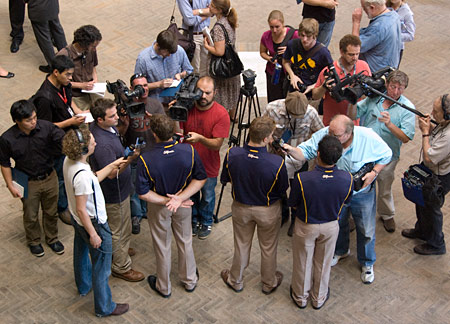On a sad day for Golden Bears, 4 teams are cut, while rugby survives as ‘varsity club’ squad
Chancellor Birgeneau and Athletic Director Barbour announce changes to Cal Athletics - including a reduction in the number of intercollegiate teams from 29 to 24 - in an effort to put the program on a financially sustainable footing.
September 29, 2010
On what an emotional Sandy Barbour called “a difficult and painful day,” the Cal athletic director and Chancellor Robert Birgeneau laid out a tough new course for intercollegiate sports at Berkeley: the elimination of four teams — baseball, men’s and women’s gymnastics and women’s lacrosse — and redesignation of rugby from intercollegiate to varsity-club status.
“Cal Athletics is not immune to the effects of the recession, and the financial realities affecting this campus,” Barbour said during a packed news conference Tuesday, at which she was joined by Birgeneau and Frank Yeary, Berkeley’s vice chancellor for administration. “The financial imperatives dictate that our reliance on campus support must be reduced.”
The action comes after more than a year of severe cost-cutting measures across the campus, and in the wake of calls to scale back subsidies to the athletics program that now total more than $12 million a year. The cuts are expected to save an estimated $4 million annually in direct and indirect costs, and to hold down future cost increases. With additional help from new revenue-generating efforts, campus officials hope to reduce campus budget support for the program to around $5 million by 2014.
The university gave the department $7.7 million in 2008-09 to subsidize an operating budget of $64.6 million, most of which comes from ticket sales, corporate sponsorships, fees for broadcast rights, endowment income and donations from Cal boosters. The campus also loaned the department $5.8 million.

At Tuesday's press conference, emeritus professor Roberta Park, a scholar of sports and a former Cal field hockey coach, praises campus administrators for the sensitive way in which they made their difficult decisions on spending cuts by Intercollegiate Athletics.
While no public funds are spent on Cal’s athletics program, Berkeley’s Academic Senate in November urged the chancellor to take “immediate action” to restore Intercollegiate Athletics to “its intended self-supporting basis.” On Tuesday, Birgeneau cited the campus’s ongoing financial woes — including, he noted, 500 staff layoffs with more expected, a two-year freeze on faculty hires and dramatic fee hikes for students — and made clear athletics could not escape its share of cutbacks.
“This package of decisions,” Birgeneau said, “will result in a sustainable, financially responsible program that will remain broad-based and fully capable of continuing to support our commitment to excellence in the university’s every endeavor, while maintaining the indispensable role athletics plays as an engine of philanthropy for the entire campus, and for community building.”
The chancellor added that Berkeley’s remaining 24 intercollegiate squads are now safe from elimination. “With this decision,” declared Birgeneau, “the cutting of teams is over. This is it.”
Dropping the four teams will reduce the number of full-time coaches at Cal by 13 — five head coaches and eight assistants — for a savings of roughly $1.1 million. Of 814 student-athletes, 163 are affected by the moves, including the 61-man rugby squad.
“I am deeply saddened by the impact that this will have on the student-athletes and coaches in these sports, and their communities,” said Barbour. But she insisted that “any solutions must result in a program that is able to sustain comprehensive excellence,” and said that simply making across-the-board cuts — without eliminating any teams — “would have had a dramatic impact on the competitive abilities of every single one of our teams, and the capability of our department to provide student-athletes with what they need to succeed.”
According to the department’s figures, Cal Athletics has been understaffed on a per-student basis, ranking last in the Pac-10 in total number of staff for each student-athlete, and seventh in sports-medicine staff.
Birgeneau vowed to “do everything in our power to help student-athletes, coaches and staff cope with the difficult challenges of this necessary transition.” He said the campus would honor existing scholarships for students who choose to stay, and assist those who decide to transfer to other schools to pursue their athletic careers.
He noted that even after the changes take effect in 2011-12, Stanford will be the only school in the Pac-10 conference to field more intercollegiate teams than Berkeley. Cal will now have 11 men’s and 13 women’s squads, matching UCLA’s program. Along with financial impact and history of competitive success, compliance with Title IX requirements for gender equity was a key consideration in deciding which teams to cut.

Facing a media scrum after the press conference, three Cal rugby players discuss their reaction to the news that their national champion team was being moved to varsity club status.
Asked about redesignating the successful men’s rugby squad, Barbour said that “one of the factors” was the belief that with “proper university support,” the team will still be able to compete “for the exact same national championships” as it did as an intercollegiate team. All teams in the new “varsity club” classification — for now, a category of one — will report to the vice chancellor for administration.
As head coach Jack Clark and several other staff and student-athletes from the rugby squad looked on from the back of the room, the chancellor made a point of recognizing “the human toll” the decision would have on members of the campus community, from staff and students to donors and Barbour herself.
“I just cannot emphasize too much my admiration for Sandy Barbour as director of athletics for biting the bullet on this,” said Birgeneau, noting her close personal relationships with coaches and athletes.
He insisted, though, that there is no alternative but to make athletics financially sustainable, a goal for which the campus was “on track” before it was hit by recession and state-funding cuts to the UC system. The budget gap in intercollegiate sports, he said, was simply “exacerbated by the funding crisis.”
Also: Chancellor announces new plan for Cal Athletics’ future (with FAQ and letter to campus community)